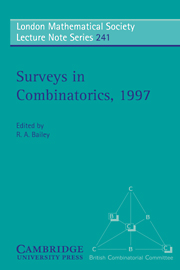Book contents
- Frontmatter
- Contents
- Preface
- M13
- The Harmonious Chromatic Number and the Achromatic Number
- Computer Construction of Block Designs
- Finite Quasiprimitive Graphs
- Tree Width and Tangles: A New Connectivity Measure and Some Applications
- Minor-monotone Graph Invariants
- Some Applications of Algebraic Curves in Finite Geometry and Combinatorics
- New Perspectives on Interval Orders and Interval Graphs
- Approximate Counting
- Author Index
- Subject Index
Finite Quasiprimitive Graphs
Published online by Cambridge University Press: 29 March 2010
- Frontmatter
- Contents
- Preface
- M13
- The Harmonious Chromatic Number and the Achromatic Number
- Computer Construction of Block Designs
- Finite Quasiprimitive Graphs
- Tree Width and Tangles: A New Connectivity Measure and Some Applications
- Minor-monotone Graph Invariants
- Some Applications of Algebraic Curves in Finite Geometry and Combinatorics
- New Perspectives on Interval Orders and Interval Graphs
- Approximate Counting
- Author Index
- Subject Index
Summary
Summary A permutation group on a set Ω is said to be quasiprimitive on Ω if each of its nontrivial normal subgroups is transitive on Ω. For certain families of finite arc-transitive graphs, those members possessing subgroups of automorphisms which are quasiprimitive on vertices play a key role. The manner in which the quasiprimitive examples arise, together with their structure, is described.
Introduction
A permutation group on a set Ω, is said to be quasiprimitive on Ω if each of its nontrivial normal subgroups is transitive on Ω. This is an essay about families of finite arc-transitive graphs which have group-theoretic defining properties. By a quasiprimitive graph in such a family we shall mean a graph which admits a subgroup of automorphisms which not only is quasiprimitive on vertices, but also has the defining property of the family. For example, in the family of all arc-transitive graphs, a quasiprimitive graph is one with a subgroup of automorphisms which is both quasiprimitive on vertices and transitive on arcs. (An arc of a graph Γ is an ordered pair of adjacent vertices.)
First we shall describe an approach to studying several families of finite arctransitive graphs whereby quasiprimitive graphs arise naturally. The concept of quasiprimitivity is a weaker notion than that of primitivity for permutation groups, and we shall see that finite quasiprimitive permutation groups may be described in a manner analogous to the description of finite primitive permutation groups provided by the famous theorem of M. E. O'Nan and L. L. Scott [17, 30]. There are several distinct types of finite quasiprimitive permutation groups, and several corresponding distinct types of finite quasiprimitive graphs.
Information
- Type
- Chapter
- Information
- Surveys in Combinatorics, 1997 , pp. 65 - 86Publisher: Cambridge University PressPrint publication year: 1997
Accessibility standard: Unknown
Why this information is here
This section outlines the accessibility features of this content - including support for screen readers, full keyboard navigation and high-contrast display options. This may not be relevant for you.Accessibility Information
- 36
- Cited by
